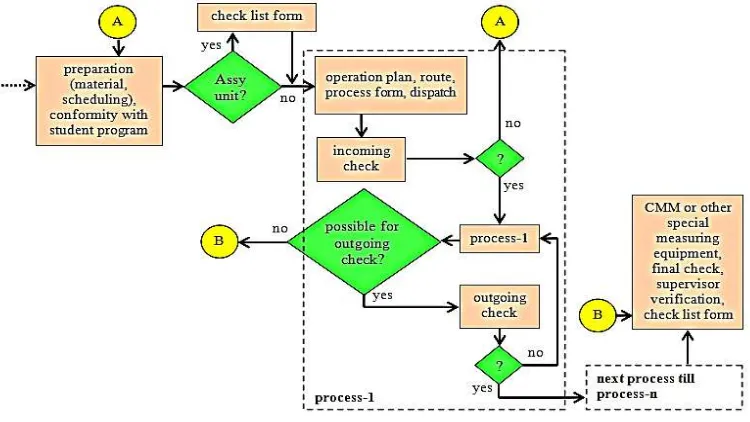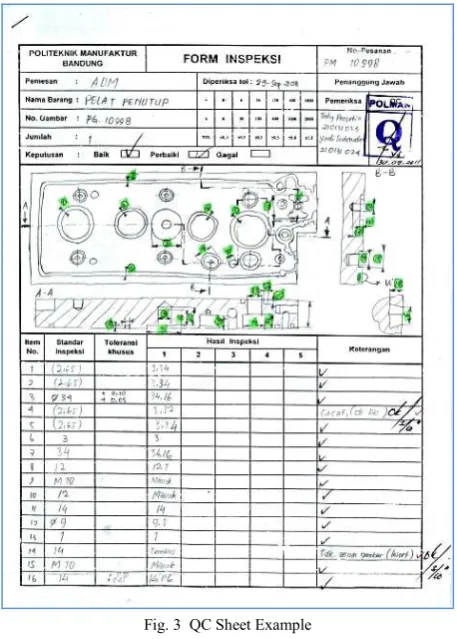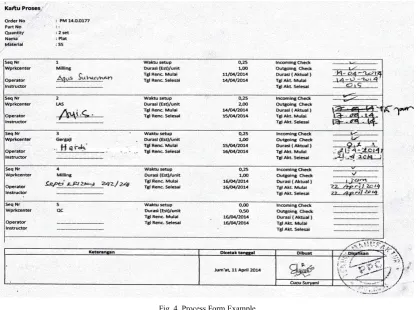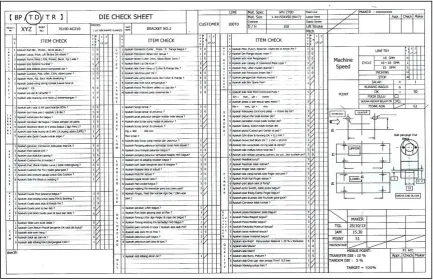Quality Culture Development Through PBE
Abstract
-
Bandung State Polytechnic for Manufacturing (POLMAN) is an institution of vocational high education that implements certain portion of practical program in the laboratory or workshop to build students skill competencies. For those, product media are created from structured exercises, combined with external inquiries from industrial parties collaboration through a system called Production Based Education (PBE). Like usual production activity, there are number of tasks and actions in its order handling procedure that are gaining production objective; quality, cost and delivery (QCD). Students, that do not have any experiences in the influence customer satisfaction at the end. This involvement is arranged by referring to which or what students competency should get. They should gain the habit and culture in following the rules related with quality in the system such as product inspection, do the quality check of final product, verify the form they used, record the data etc. Besides, they are introduced to the basic of Quality Assurance where the students have to carry out incoming and outgoing check in every process they are assigned. This will prevent the product suitability failure and avoid the rejection, and would be very beneficially for all involved parties in education and production as well; either students, lecturers and institution.Key words - quality, production based education
I. INTRODUCTION
Bandung State Polytechnic for Manufacturing (POLMAN) is an institution of vocational high education that implements certain portion of practical program in its laboratories or workshop to build students skill competencies. As known, there was the previous similar thing in the learning factory concept that integrating a set of intellectual and physical learning activities in the manufacturing process as a series of theoretical framework units and real field practicum[1]. For these practical sessions in Polman, product media are created from structured exercises, combined with external inquiries
from industrial parties collaboration, through a system called Production Based Education (PBE). This also in line with the aim for better prepare engineering students to function efficiently and adjust readily within the framework of the factories in the real world [2]. Industrial atmosphere within an educational institution can be created by replicating an industrial site plan in its workshop that could improve students‟ productive competences[3]. This collaboration concept is also a model of education program that aimed to provide workforces with new competencies and qualifications that suit for the new manufacturing generation[4].
Adopting the usual production activity, PBE order handling for customer runs comprehensively with all necessary tasks and actions needed, that are gaining production objective; Quality, Cost and Delivery (QCD). Figure-1 generally mentioned how all these activities flow, starts from customer‟s inquiry till deliver the goods. Comparing with six steps in TF-6M model that consists of receive the given order, analyze, express the readiness, execute the order, incorporate quality control and submit the order[3]; PBE -as a system- carry out the business by involving the whole parties in organization. Managerial aspect for instance, there are number of tasks related to document of quotation, negotiation, contract agreement, term of payment etc; or from technical side in addition to fabrication and machining process, the quality issue is included as well in manufacturer‟s duty which is supported by related procedures and work instructions.
Fig. 1 General Order Handling In PBE
II. METHODOLOGY
In order to have the culture in obeying the rules related with quality, in the PBE system students learn and do necessary tasks such as product inspection as a very basic thing, verify the form they have to used, record the data etc. Following Figure-2 [5] elaborates the Quality Check from previous figure into more detail that is mentioning the number of activities where production participants should contribute. Developed from Quality Check of final product like in previous quality concept, they are introduced to the basic of
Quality Assurance where the students have to carry out incoming and outgoing check in every station or process. In this case, there is an option whether the product is just component or an assembly unit that Check List Form is needed. Further, in each process there will be decided conditionally whether outgoing check is possible to carry out, otherwise it has to be done by CMM or other special measuring equipment in certain Laboratory or Section, included the Check List Form for special machine or tools, if necessary.
Fig. 2 Incoming and Outgoing Check in Each Process [5]
III.RESULT AND DISCUSSION A. Inspection and Quality Control
As known, inspection is the most common method of attaining standardization, uniformity and quality of
this session they learn basic measurement using various equipment such as calliper, micrometer, block gauge and profile projector; therefore they are capable to do product inspection or quality control in general scope.
In previous Figure-1, Quality Check placed as centralized inspection procedure for the finished product which is done in certain section called QC Lab. In this Lab a small group of students are assigned alternately to support Lecture or Supervisor In Charge. Such student group usually be on duty for one week, do the quality check for finished components before deliver to the customer. They have to fill the QC sheet form in order to determine if its dimensions are correct according to defined drawing. Figure-3 shows an example of such filled QC sheet. It is shown that the measuring product or item could be sketched on such sheet with several essential marked points and dimensions that have to be checked.
Fig. 3 QC Sheet Example
The actual result of its measurements then written down and verify whether passed or not. Actually, the advantages of this kind of inspection are better in quality check up and
Further, without leaving out product inspection culture as an important basic thing, the system then developed rather to Combined Inspection, between Floor and Centralized, which
is in line with the Quality Assurance concept. However, inspection and testing are the most common methods of Quality Control (QC), and are widely used in education to determine whether standards are being met. Quality Assurance (QA) is different from QC. It is before and during the event process concerned to prevent faults occurring in the first place[7].
It is developed from just do the quality check on final product by centralized place of inspectors, the part of responsibility of product quality is taken over to the executors, in this case, the students. They are introduced to the system where they have to carry out incoming and outgoing check in every station or process they work. Before start processing they have to ensure whether received material or pre-machined component from previous process is acceptable, and after executing the job they do so, whereas these inspection results have to be written or recorded and validated on the Process Form that attached with related technical drawing, as shown on Figure-4. There could be of course the exception(s), in a condition that outgoing check is not possible to carry out by the direct workforce, for CNC machined part that had 3 dimensional contour for instance. In this case it has to be done by certain section like QC Lab with its CMM or other more „additional‟ tasks and such condition students will have more authority on their work and pushed their capability up, and this can be achieved by doing it right every time, consistently. It also strengthen the old view and ism that „next process is our customer‟.
C. Toward The Total Quality Management
Generally, Total Quality Management (TQM) could be defined as an effective system for integrating the quality development, quality maintenance and quality improvement efforts of the various groups in an organization so as to enable production and service at the most economical level which allow for full customer satisfaction. It may be classified as a
„Management Tool‟ for many industries outstanding
improvement in product quality design and reduction in operating costs and losses[6]. TQM programs do not have to use the initials TQM. Many organizations pursue the philosophy under their own brand name. Total quality control, total quality service, continuous improvement, strategic quality management, systematic improvement, quality first, quality initiatives, are some of the many titles used to describe what TQM is[7].
responsi-bilities[7]. Though, one of TQM keyword in quality issue is
„integrating‟ all efforts at organizational scope. Therefore with good willingness of all parties the whole good ideas should be well communicated, harmonized and bundled.
Fig. 4 Process Form Example
In the PBE problem of view for instance, as an example in the order handling, the quality of single product cases possibly could easily control by awesome workforce participation; but for assembly unit or project like special purpose machine, mould, dies or such things, more management tool is needed. One of the most successful methods applied in TQM is the concept of the quality plan (Schobert & Brown, 1990). A quality plan is defined as a "document setting out the specific quality practices, resources and sequence of activities relevant to a particular service" (Stebbing, 1989, p.20). Thus a quality plan is the quality assurance scheme developed for a program or project[8]. Previous Figure-2 mentioned that if the kind of job is „assy unit‟ then a „check list form‟ is necessary to implement. This only to say that a common technical drawing is not enough to express more specifications. Such more complicated project needs a list that contain product requirements conditionally as a „quality plan‟. In many cases, this quality plan have to be defined even from the design stage, referred to the customer requirement conditionally.
As an example, following Figure-5 is a Check List Form of a Dies (stamping dies) that contained number of things to be checked by manufacturer (NTC, 2013). Such as die height, quality surface of cutting and forming result, etc. Other kind of project or assy product surely will have other specific descriptions. An Injection Mould for instance, will highlight related technical points like appeared shrink mark on the product result, air trapped, pre-dry temperature etc.
D. Devide The Authority Of Control
The TQM philosophy is large-scale and inspirational, but its practical implementation is small-scale and highly practical. By way of illustration, Joseph Juran talks of „elephant-sized‟ and „bite-sized‟ projects. He argues that the best way to tackle the „elephant-sized‟ projects is to divide them up into manageable „bite-sized‟ assignments. He recommends assigning one team related to „cutting-up the elephant‟ (Juran, 1989). Regarding „assy unit‟ handling approach for a job that categorized as a „project‟ due to its complexity level, a Personal In Charge (PIC) could be assigned.
This PIC should manage and control all necessary actions related to the job he or she assigned to, on all event across departments, as a delegated representative of higher management board. Through this project based and temporary assignment PIC has the access to „push‟ all related department head in order to ensure that the project runs well. Figure-6 illustrates this authority by the blocked arrows whereas the normal arrows represent work flow and dashed arrows accommodate feedbacks from certain task of operations, if any.
E. The External Quality Standard
that the supplier has the ability to provide the product or service consistently to the defined quality”. Therefore, PBE through Polman adopt the ISO9000 series in order to get the soul of TQM. The philosophy behind the ISO9000 series is
that quality should be built into the systems and procedures of the organization, where the emphasis is on prevention rather than cure.
Fig. 5 Check Sheet Form Example
To be able to meet the demands of ISO9000 an organization has to build quality in at each stage, from design through to delivery, assessment and evaluation, through a formal and rigorous management system to ensure conformity of the product to its specification[7]. This would be very
beneficially for all involved parties in education and production as well; either students, lecturers and institution. Students will have the culture in obeying the rules related with quality whereas lecturers and institution could perform better in satisfying the customers.
Fig. 6 Illustration of Person In Charge (PIC) for Assy Job
IV.CONCLUSION
Through the PBE (Production Based Education) system in Polman, number of tasks and actions in its order handling procedure are implemented in the education process that are gaining the QCD (quality, cost and delivery), as the objective of production activity. Referred to the design of study program the students are involved in controlling the product quality, therefore they got the capability to do product
inspection or quality control in general scope, and carry out incoming and outgoing check as well, in every station or process they are assigned.
Since the students are experiencing all issues about production while learning, their quality culture are developed. This would be very beneficially for all involved parties in education and production as well. Students will have the culture in obeying the rules related with quality whereas lecturers and institution could perform better in satisfying the customers.
REFERENCES
[1] Jorgensen, G.E., Lamancusa, J.S., Zayas-Castro, J.L., Ratner, J. (1995).
“The Learning Factory Curriculum Integration of Design and Manufacturing”, Proc. of the Fourth World Conference on Engineering Education; St. Paul, MN, October 15-20.
[2] Alptekin S.E, Pouraghabagher R, Mc Quaid P and Waldorf D, “Teaching Factory”, Proceedings of the 2001 American Society for Engineering Education Annual Conference & Exposition, (2001), session 3563, American Society for Engineering Education
[3] Martawijaya DH, “Developing A Teaching Factory Learning Model To Improve Production Competencies Among Mecha-nical Engineering
Students In A Vocational Senior High School”, Journal of Technical Education and Training (JTET), Vol.4, No.2, December 2012, ISSN 2229-8932
[4] Ilyas PI and Semiawan T 2012 Production Based Education (PBE): “The Future Perspective of Education on Manufacturing Excellent”, SciVerse ScienceDirect, Procedia Social and Behavioral Sciences 52 (2012) p5-14 [5] Ananto G and Solihin Y, “Quality Issue As A Part Of PBE (Production
Based Education) System In Polman”, Proceeding of Steman, (2014), Politeknik Manufaktur Bandung, ISBN 978-979-17047-5-5.
[6] “Quality Control”/ accessed on June, 2014 http://www.newagepublisher.com/samplechapter
[7] Sallis E, “Total Quality Management in Education”, (2002) Kogan Page Ltd, London
[8] Mounteney, Peter and Navaratnam KK, “Implementing Total Quality
Management in Vocational Education”,Wellington, New Zealand: New Zealand Qualifications Authority, (1992), downloaded June 2014,



